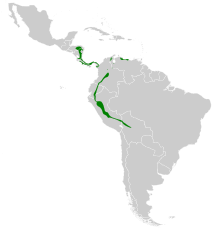Violet-headed hummingbird
| Violet-headed hummingbird | |
|---|---|
 | |
| female | |
| Scientific classification | |
| Kingdom: | Animalia |
| Phylum: | Chordata |
| Class: | Aves |
| Order: | Apodiformes |
| Family: | Trochilidae |
| Genus: | Klais L. Reichenbach, 1854 |
| Species: | K. guimeti |
| Binomial name | |
| Klais guimeti (Bourcier, 1843) | |
 | |
| Range of K. guimeti | |
The violet-headed hummingbird (Klais guimeti) is a species of hummingbird in the family Trochilidae. It is monotypic of the genus Klais.
It is found in Bolivia, Brazil, Colombia, Costa Rica, Ecuador, Honduras, Nicaragua, Panama, Peru, and Venezuela. Its natural habitats are subtropical or tropical moist lowland forest, subtropical or tropical moist montane forest, and heavily degraded former forest.
Description
Violet-headed hummingbirds are on average 8.1 cm (3.2 in) in length with a short, straight bill that averages 13 mm (0.51 in) in length.[2] The head and throat of the male are intense violet or blue (depending on the angle viewed) with white spots behind each eye that stands out against the dark head. The back is metallic bluish-green (or bronze-green depending on the angle) and breast is green fading to a grey belly. The tail is green with tiny white-grey tail spots. The wings are black.[2][3][4][5]
_JCB.jpg)
The female is duller with a blue cap, green back and grey throat, breast and belly. The wings and tail are the same as the male. The female also has the white spot behind the eye.[2][3][4][5]
Taxonomy
The violet-headed hummingbird was described by Jules Bourcier in 1843. The species name is after M. Guimet who was a chemist from Lyons, France.[4] It is in the hummingbird family (Trochilidae).[6]
Range
The violet-headed hummingbird ranges from Central America well into South America. This includes Honduras, Nicaragua, Costa Rica and Panama in Central America and western Venezuela, Colombia, Ecuador, Peru, northern Brazil, western Venezuela and northern Bolivia.[2][3][4][5] The species tends to be local in distribution, common in some areas and rare in other seemingly identical areas.[2][7]
The violet-headed hummingbird occurs in the mountains and has been recorded to occur from 200 to 850 m (660 to 2,790 ft) in Costa Rica,[4] from 400 to 1,850 m (1,310 to 6,070 ft) in Colombia[2] and 150 to 1,900 m (490 to 6,230 ft) in Venezuela.[5]
Habitat
Violet-headed hummingbirds are found on the edges of humid primary forest, openings in secondary forests, in shrub and thicket clearings[2][3] and in various human modified habitat such as Stachytarpheta hedges in Costa Rica[8] and shade-grown coffee plantations in Venezuela.[7]
Breeding
In Costa Rica, males sing in loose leks[2] beginning in October and intensifying until the breeding season in December.[9] The chorus continues until the dry season causes the flowers to disappear in February and March. The chorus picks up again when the rains begin again in April, but the heavy rains of May shut the chorus down again until October.[9] The leks are located 5 to 18 m (16 to 59 ft) above the ground on the edge of clearings where the males sing conspicuously from slender dead twigs.[10] Occasionally, an individual will sing solo without other violet-headed hummingbirds nearby.[2]
The nest is a mossy cup[2] built 1 to 5 m (3.3 to 16.4 ft) above forested mountain streams. They are normally built in February,[11] but sometimes as early as January.[2] The last young fledge in May.[2][11]
Diet
The violet-headed hummingbird drinks nectar from understory flowering shrubs as well as taking small insects[7] on the wing.[2] In Costa Rica, a particular fondness for Stachytarpheta flowers has been reported with as many as one individual every 5–7 m (16–23 ft) on a hedge near Murcia.[8]
Relationship with humans
The violet-headed hummingbird has been designated as a species of Least Concern due to its large range and ability to exist in human modified habitat.[1][7] The flowering shrubs near Murcia, Costa Rica, were reported to be in an area cleared for agriculture with very few trees.[8]
References
- 1 2 BirdLife International (2012). "Klais guimeti". IUCN Red List of Threatened Species. Version 2013.2. International Union for Conservation of Nature. Retrieved 26 November 2013.
- 1 2 3 4 5 6 7 8 9 10 11 12 13 Hilty & Brown 1986, p. 262.
- 1 2 3 4 Dunning & Ridgely 1982, p. 225.
- 1 2 3 4 5 Skutch 1958, p. 5.
- 1 2 3 4 de Schauensee & Phelps 1978, p. 139.
- ↑ Hilty & Brown 1986, p. 249.
- 1 2 3 4 Jones et al. 2002.
- 1 2 3 Skutch 1958, p. 6.
- 1 2 Skutch 1958, p. 9.
- ↑ Skutch 1958, pp. 9–10.
- 1 2 Skutch 1958, p. 11.
Bibliography
- Dunning, John S.; Ridgely, Robert S. (1982). South American Land Birds: A Photographic Aid to Identification. Harrowood Books. ISBN 978-0915180226.
- Hilty, Steven L.; Brown, William L. (1986). Guide to the Birds of Colombia. Princeton University Press. ISBN 978-0691083728.
- Jones, Jason; Ramoni-Perazzi, Paolo; Carruthers, Erin H.; Robertson, Raleigh (2002). "Species Composition of Bird Communities in Shade Coffee Plantations in the Venezuelan Andes" (PDF). Ornithologia Neotropical. 13: 397–412.
- de Schauensee, Rodolphe Meyer; Phelps, William H. (1978). A Guide to the Birds of Venezuela. Princeton University Press. ISBN 978-0691082059.
- Skutch, A.F. (1958). "Life history of the Violet-headed Hummingbird" (PDF). Wilson Bulletin. 70 (1): 5–19.
External links
| Wikimedia Commons has media related to Klais guimeti. |
| Wikispecies has information related to Klais guimeti |
- BirdLife species factsheet for Klais guimeti
- "Violet-headed hummingbird media". Internet Bird Collection.
- Violet-headed hummingbird photo gallery at VIREO (Drexel University)
- Violet-headed hummingbird species account at NeotropicalBirds (Cornell University)
